Love the DXing. Hate the QSLing!
Most of us treat QSLing as a necessary evil when looking for awards. Even casual operating will result in a flood of QSLs arriving at the bureau. The problem is that QSLing becomes very expensive if you do a lot of operating. It’s not just the horrendous cost of postage, but the cost of having them professionally printed has risen considerably over the past few years. The ARRL’s “Logbook of the World” (LoW) becoming active has reduced costs enormously. The Internet e-QSL system works well but is not acceptable for most of the top awards. Writing individual QSLs by hand is time consuming and laborious in the extreme. There is a better way!
Electronic Log books such as DXLog, WriteLog, DX4Win and others have the facility to print labels. The programs can be adjusted to print any number of labels per page or one label per page and in fact print directly onto the QSL card. Most inkjet printers and laserjet printers will accept and print 90mm x 140mm cards fed into the printer end on as long as the card used is not too thick. Standard QSL stock is 225 grams. Small printers will have a problem with the 225 gram thickness but will process the thinner 140 gram stock quite nicely.
Ten years ago graphics programs were the domain of the professional printing houses. Now you can buy Corel Draw 7.0 or Microsoft Publisher 2000 and other graphics programs relatively cheaply to design your own QSL cards. In fact you can now have complete control over the design, manufacture and processing of your own cards. The ZL2AS QSL card below is a simple one I designed for handwritten information.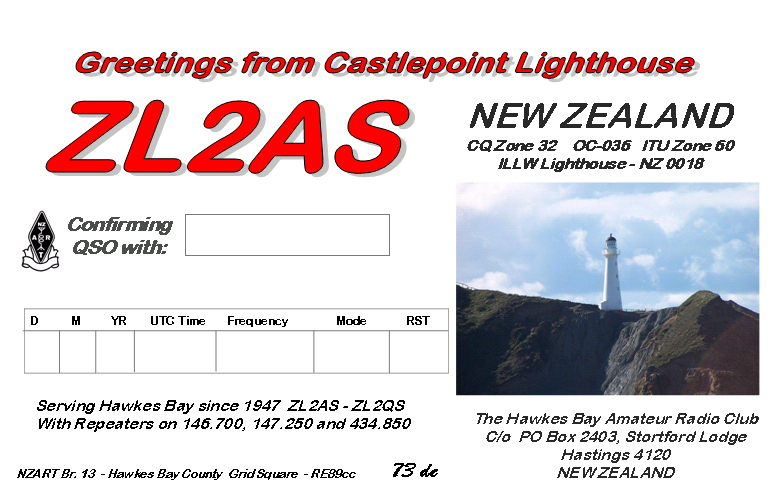
There are specific QSL design programs available. They did not suit what I wanted to do as most of them had quite a few formats but wouldn’t allow me to have the “blank space” where I wanted it. Their designs where based on filling out a QSL with pen and ink. I don’t do pen and ink these days! Have a look at these websites below.
http://hamradiosoftware.com/HAM/qsldes.html or
http://www.rsars.org.uk/QSLDIY.HTM or
http://www.df3cb.com/bv/bvfeatures.html or
http://www.sm7tog.com/download.html (for icons)
I use Microsoft Publisher working with Windows XP to design the QSL. You could also use MS Word although the Microsoft way of doing graphics in Word is a bit unusual and unwieldy. You don’t have to be a graphics designer because QSL cards are not difficult to lay out and you may have thousands of examples in your collection that you can mine for ideas. If you don’t feel confident in designing it yourself, there are lots people around who dabble in Photoshop and other graphics programs and can do it easily. It is a simple matter to pirate the best of the designs and adapt them your needs. The text boxes and various elements of your design are easily moved around the screen.
As you do the design on your card the Microsoft Publisher program will set up four identical QSLs on an A4 page. Other graphics programs will handle it in a different way. You will notice in the ZM4T QSL below that the centre area is left clear for the program to print the QSO information from the logging program. The key is deciding where to put your reference point on the card. My reference point all my designs is 3mm to the right of the G in the word “Confirming” and level with the word. (See the ZM4T) QSL below. Once you have that point then you can set the label parameters in DX4Win Print|Edit window. The cards go into the tray end on side to print UP and the Logo/Name on the right side of the card first.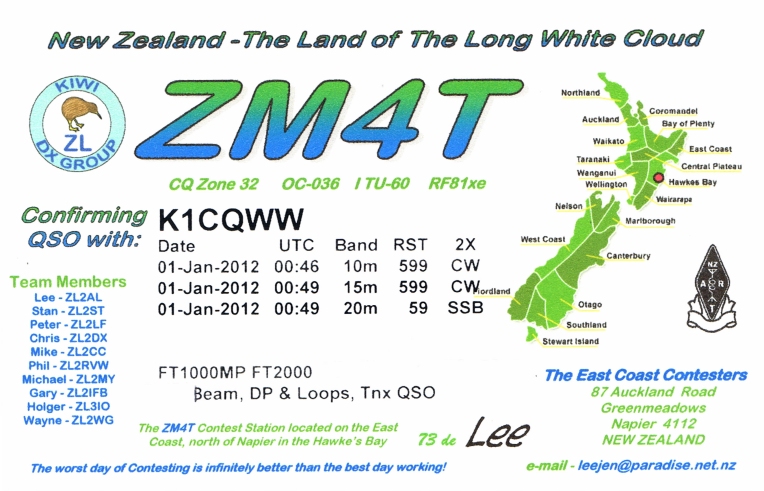 When your design is completed it is a simple matter to print off a few A4 pages, cut them into QSLs with scissors and check the Logging Program registration of the printing of the QSO information on your printer. Because I do a lot of QSLing, I have invested in a good quality guillotine and it’s now very easy to chop up a few hundred QSLs from the A4 pages by setting the dimensions to standard QSL size of 90mm x 140mm.
When your design is completed it is a simple matter to print off a few A4 pages, cut them into QSLs with scissors and check the Logging Program registration of the printing of the QSO information on your printer. Because I do a lot of QSLing, I have invested in a good quality guillotine and it’s now very easy to chop up a few hundred QSLs from the A4 pages by setting the dimensions to standard QSL size of 90mm x 140mm.
See the ZL2AJ design below. When the four QSL template page is finalized, go into any good stationery supplier and ask for Kaskad A4, 140 gram paper in packs of 250 with your choice of colour. 140Gm is perfect as it will go through most inkjet and laserjet printers if you want to print them yourself. All colours of the rainbow are available. Or you can head off to your local photocopy house to have them photocopied and cut exactly to size. 250 sheets will make 1000 QSL cards.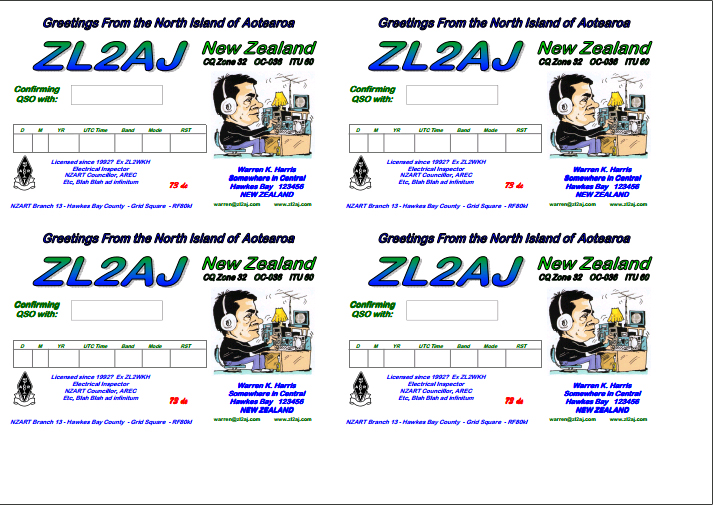
The cost varies from 4 to 8 cents per sheet for first class laser copying. I am sure that a better price could be found by shopping around. The cost of cutting to size is about $5.00 per pack of 250 sheets. The cost of the Kaskad sheets is around $25.00 per 250 sheets. The total cost works out to around $40 – $75 per 1000 QSLs depending on how much of the process you do yourself. You could even print your QSLs on plain A4 white paper. The cost would be around $7.00 for 2000 QSLs. They would be thin but would satisfy the requirements for a QSL.
I have used DX4Win Logging program since the early 1990s and am up to version 8.05 It gives me full control of where the information prints on the card and mine is set up to print up to 5 QSOs per card
The finished ZM4T QSL with the QSO information is shown above. I use white card and print it on my cheap Brother printer. You will note that the DX4WIN logging program fills in the QSO information in the correct place on the card. This card shows four QSOs for XR0X and the logging program also inserts a few lines at the bottom with the equipment info, the operator’s name and PSE or TNX QSL determined by the program. All the information is on one side of the card which makes life easier for QSL managers.
The ZL2AL QSL design below shows the front side graphics and the second is the back of the QSL. It was been printed commercially by UX5UO Print with a cartoon on the front ready for printing QSO information on the back. That same reference point is used for print registration. The cost saving of not having to purchase about 20,000 labels was considerable. I started out using a cheap Inkjet printer but soon found that a cheap Canon black and white only laser printer with a toner cartridge was much more economical to run as the printing on the back of the card was minimal.
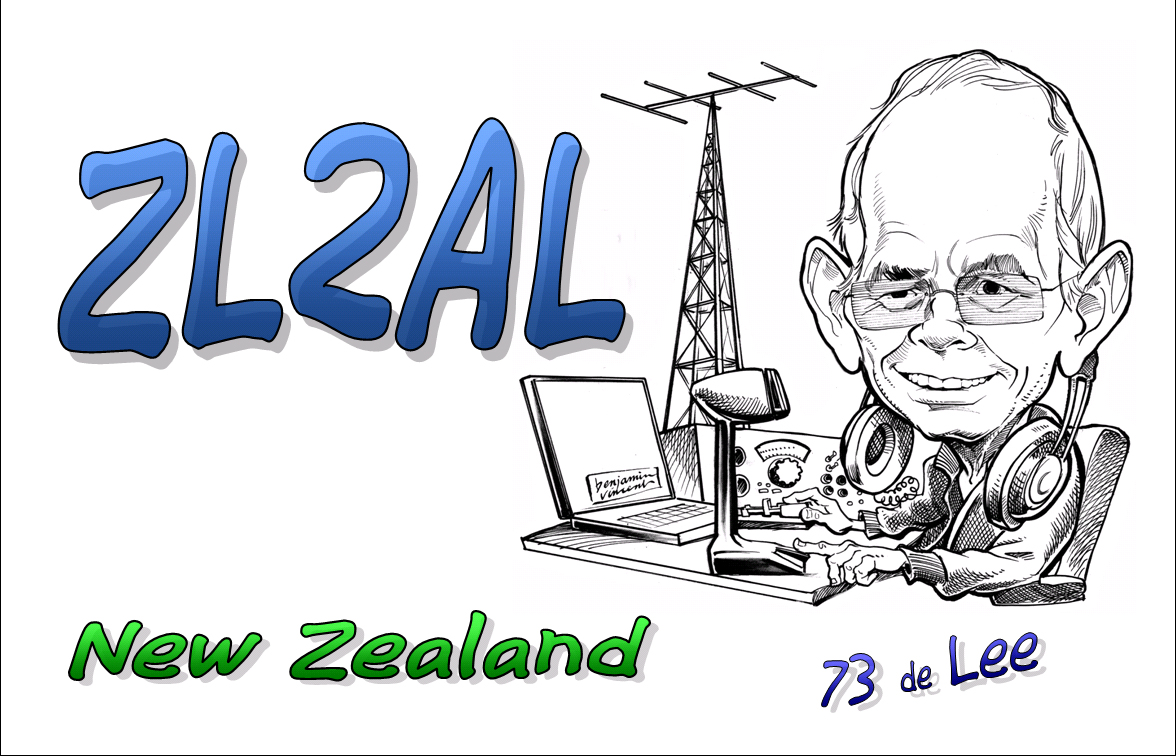
The front side of the UX5UO printed card. The cartoon graphic was created by a company in the USA to add a little humour to sometimes humourless QSLs.
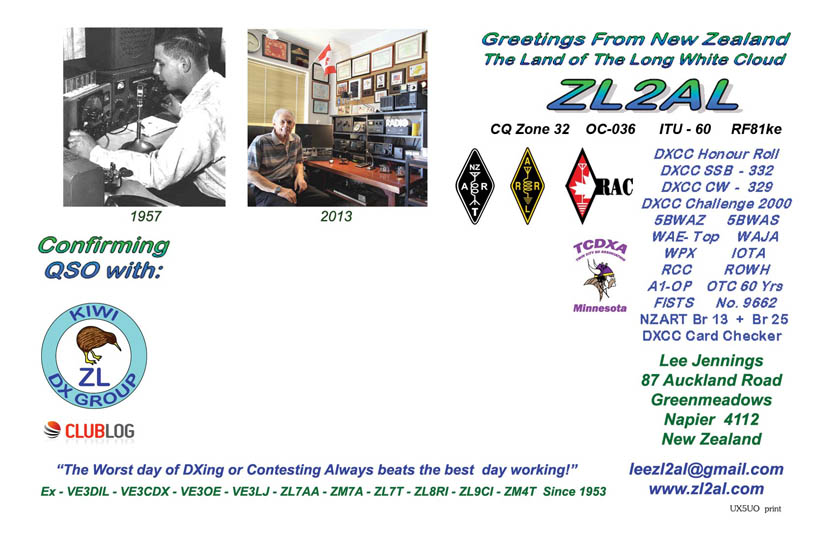
Latest ZL2AL design using a very old MS Publisher graphics program. This is the back of the card. Front is shown above.
n
The ZL7T Design is shown below. We made about 3,000 of them.
You could even print directly from your printer and cut the QSLs yourself if you only want small runs and want to reduce the cost even further. The cost of a printer ink cartridge must be taken into consideration. Cartridges are expensive buying from your local NZ supplier. I used an old Brother 130C multi function printer for a few years but it was expensive to run. I discovered that I can order 4 sets of cartridges (made in China and I will happily void warranty!!!) for $70 NZD delivered purchased on eBay.
I have a specifically dedicated Canon BP3120 Laser B/W only printer that I use for feeding the 90 x 140mm cards end ways from the bottom tray to print the black ink QSO information on. I can print thousands of QSL cards with one cartridge. A new printer is cheap at around $70 or so. I also use a QSL Manager program called Hamcall by Buckmaster which can be set up to print directly onto C6 size envelopes. The Hamcall CD is a database of 1.3 million names and callsigns. Addresses and call letters are updated monthly from their website. After I have printed ten or fifteen “QSL Direct” cards, I can call up the names and addresses from the Hamcall CD and print the envelopes. I also use Hamcall to print my own “return” C6 envelopes with my name on them. No labels are involved – Ever!
I also have a small sheet of paper about the size of the QSL card to enclose with the QSL which tells the other recipient a little about myself, my family and the area I live in. I am quite amazed at the number of letters I get in response to the info sheet telling me about their history and their families. It’s much more interesting when you know a little more about who you were talking to other than just name, rank and serial number! Typically I can receive 50 cards or more from the QSL bureau and process them in 15 or 20 minutes. And yes, there is a place on the card where I sign each one individually.
The system works very well for me and saves a lot of time, effort and money in the process of producing QSL cards. Please contact me at [email protected] if you don’t feel comfortable with designing a card. I would be happy to help set up a template for you and then you can simply have it copied for inexpensive QSLing.
73 de Lee ZL2AL

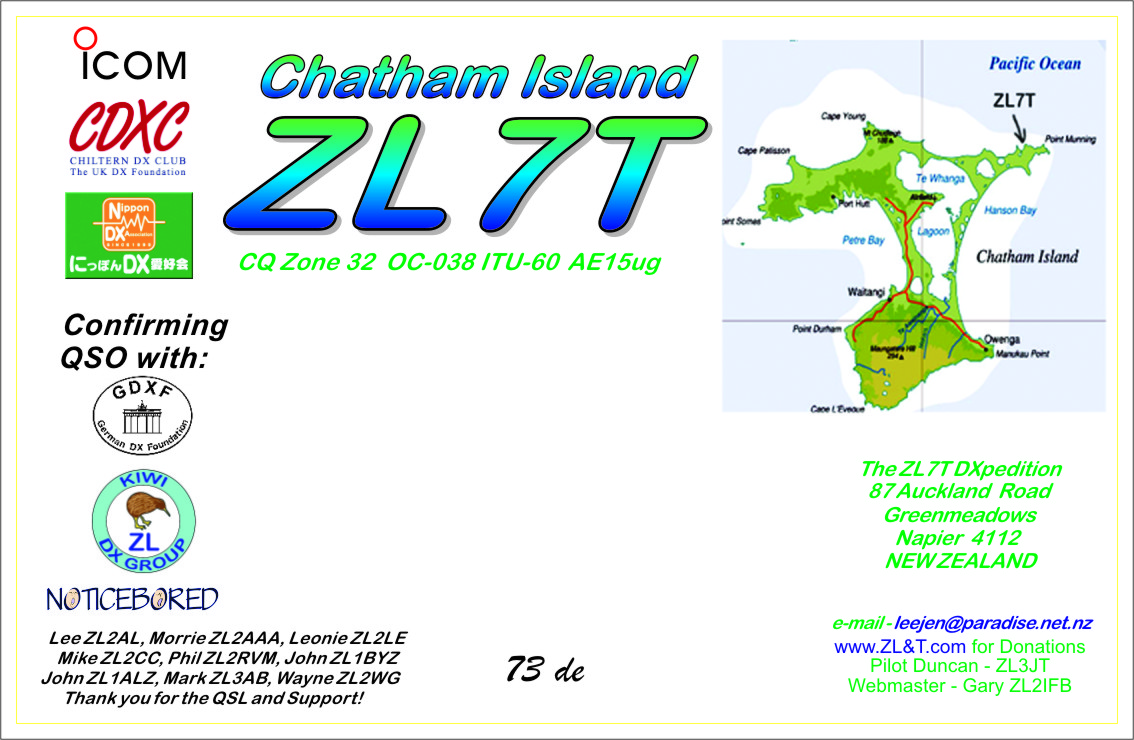
Hi Lee, This posting is extremely well presented and I enjoyed reading it.
I have never utilised the QSL function from my logging program but intend to now. I produce my own photo QSLs using photographs that have been edited on photoshop, run them off 250-500 at a time at the Stationary Warehouse when they have specials on for colour photos. I still use labels however and some of the ideas from your post will help with keeping costs and uage of time down. 73 Bruce
Thanks Bruce! 73, Lee ZL2AL